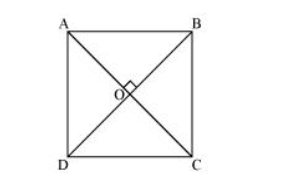Show that if the diagonals of a quadrilateral are equal and bisect each other at right angles, then it is a square.
Question:
Show that if the diagonals of a quadrilateral are equal and bisect each other at right angles, then it is a square.


Solution:
Let us consider a quadrilateral ABCD in which the diagonals AC and BD intersect each other at O. It is given that the diagonals of ABCD are equal and bisect each other at right angles. Therefore, AC = BD, OA = OC, OB = OD, and ∠AOB = ∠BOC = ∠COD = ∠AOD = 90º. To prove ABCD is a square, we have to prove that ABCD is a parallelogram, AB = BC = CD = AD, and one of its interior angles is 90º.
In $\triangle A O B$ and $\triangle C O D$,
$\mathrm{AO}=\mathrm{CO}$ (Diagonals bisect each other)
$\mathrm{OB}=\mathrm{OD}$ (Diagonals bisect each other)
$\angle A O B=\angle C O D$ (Vertically opposite angles)
$\therefore \triangle \mathrm{AOB} \cong \triangle \mathrm{COD}(\mathrm{SAS}$ congruence rule)
$\therefore \mathrm{AB}=\mathrm{CD}(\mathrm{By} \mathrm{CPCT}) \ldots(1)$
And, $\angle O A B=\angle O C D($ By CPCT $)$
However, these are alternate interior angles for line AB and CD and alternate interior angles are equal to each other only when the two lines are parallel.
$\therefore \mathrm{AB} \| \mathrm{CD} \ldots(2)$
From equations (1) and (2), we obtain
$\mathrm{ABCD}$ is a parallelogram.
In $\triangle \mathrm{AOD}$ and $\triangle \mathrm{COD}$
$\mathrm{AO}=\mathrm{CO}$ (Diagonals bisect each other)
$\angle \mathrm{AOD}=\angle \mathrm{COD}$ (Given that each is $90^{\circ}$ )
$O D=O D($ Common $)$
$\therefore \triangle \mathrm{AOD} \cong \triangle \mathrm{COD}($ SAS congruence rule $)$
$\therefore \mathrm{AD}=\mathrm{DC} \ldots(3)$
However, $A D=B C$ and $A B=C D$ (Opposite sides of parallelogram $A B C D$ )
$\therefore \mathrm{AB}=\mathrm{BC}=\mathrm{CD}=\mathrm{DA}$
Therefore, all the sides of quadrilateral $A B C D$ are equal to each other.
In $\triangle \mathrm{ADC}$ and $\triangle \mathrm{BCD}$,
$A D=B C($ Already proved $)$
$\mathrm{AC}=\mathrm{BD}$ (Given)
DC = CD (Common)
$\therefore \triangle \mathrm{ADC} \cong \triangle \mathrm{BCD}(\mathrm{SSS}$ Congruence rule)
$\therefore \angle A D C=\angle B C D(B y C P C T)$
However, $\angle \mathrm{ADC}+\angle \mathrm{BCD}=180^{\circ}$ (Co-interior angles)
$\Rightarrow \angle A D C+\angle A D C=180^{\circ}$
$\Rightarrow 2 \angle \mathrm{ADC}=180^{\circ}$
$\Rightarrow \angle \mathrm{ADC}=90^{\circ}$
One of the interior angles of quadrilateral $A B C D$ is a right angle.
Thus, we have obtained that $A B C D$ is a parallelogram, $A B=B C=C D=A D$ and one of its interior angles is $90^{\circ}$. Therefore, $A B C D$ is a square.
Click here to get exam-ready with eSaral
For making your preparation journey smoother of JEE, NEET and Class 8 to 10, grab our app now.
